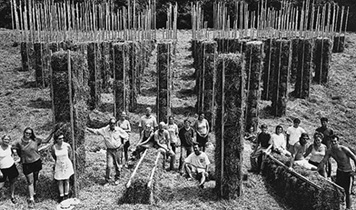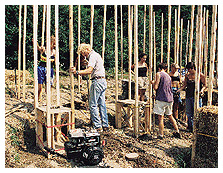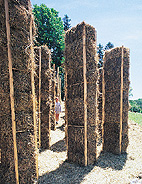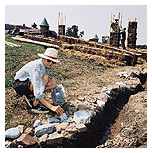
| SEARCH |
| YELLOW PAGES |
| WHITE PAGES |
| UVM HOME |


Hay Days
Art meets agriculture at Shelburne Farms
Most people picture “summer art class” as an outdoor adventure
in landscape painting, and Vermont offers no shortage of compelling
vistas for the two-dimensionally-inclined. But the nineteen art
students who signed on to “The Mentor Experience” last summer
traded in their easels for power augers, and got into the landscape
— literally. Under the direction of art professors Bill Davison,
Ed Owre, and Kathleen Schneider, they spent three rainy weeks
constructing a site-specific sculpture on a hillside previously
occupied by dairy cows as part of a larger community curatorial
effort known as “the HAY project.”
 “It’s been a hell of a lot of physical work,” said Owre, shoring
up one of the 150 “pillars” of stacked hay bales in “Ricochet:
Herd Swale Mosque” on the day before its official opening at Shelburne
Farms last July.
“It’s been a hell of a lot of physical work,” said Owre, shoring
up one of the 150 “pillars” of stacked hay bales in “Ricochet:
Herd Swale Mosque” on the day before its official opening at Shelburne
Farms last July.
Owre handled most of the engineering on the triangular structure,
which occupies 6,500 square feet of pastureland on the former
estate and model farm developed by William Seward Webb. Sixty
hours of surveying later, even he had new appreciation for “the
art of measuring,” as he phrased it, noting, “These students could
probably build their own house after this.”
Leading the way through the fourteen-foot spruce timbers like
a farmer parting stalks of prize corn, Owre showed how the tops
of the pillars echo the landscape, while the bales of hay contained
within them form a level line. Every angle, and shadow pattern,
offers a surprising new view. From the top of the slope, which
looks across at the newly renovated turn-of-the-century farm barn,
you get the impression of looking out over a studded rooftop awaiting
a second story.

That tension between the irregular topography of the land and
the hard geometry of the triangular design lends the piece a Stonehenge
feel, of nature partnered with human industry. Closer to home,
the interplay has political implications. “Combining agricultural
and architectural references,” Fleming Museum curator Janie Cohen
wrote in the exhibit catalogue, “the design interweaves the land
uses that compete for the soul of Vermont.”
In that respect, “Ricochet” directly reflects the mission of the
HAY project. The sculpture is a part of a three-month effort to
draw attention to the most important, and humble, crop in Vermont
through lectures and exhibits located primarily at Shelburne Farms.
But like the other like-spirited efforts on exhibit — curator
Pat Parsons also commissioned a hay art piece from site-specific
artist Robert Chambers — the organic endeavor is also a recognition
of the working landscape, and its tremendous aesthetic contribution
to the daily lives of Vermonters. Against a backdrop of dwindling
dairy farms and suburban sprawl, it is a poignant partnership
of art and agriculture.
That connection was not lost on the toiling students. “We developed
a new appreciation for construction workers and farmers,” Alexis
Curreri remarked with false annoyance as she dug at the soft earth
alongside the stream that divides the piece in two. Her efforts,
coordinated with two fellow students struggling to move a back-breaking
boulder, looked less like art class than the last day of Outward
Bound. Exhibiting the team work developed over days of digging
together, the workers lowered the weighty rock into the hole Curreri
had prepared for it. Now a handy cross-creek “stepping stone,”
it looked like it had been there for years.

The students also learned that art is not set in stone — or hay.
It is an evolving, and in this case highly collaborative, process.
When the original design of “Ricochet” was modified from a rectangle
to a square to a triangle due to rocky soil and bad weather, “they
were initially kind of upset,” says Schneider. Over time, “they
began to understand and grow fond of the new design,” she said.
“You make mistakes, and correct them.” Not a single student dropped
the class, which turned out to be a practical lesson in life as
well as land moving.
Of course there were some moments of “justified whining,” as Davison
puts it. “We worked through some very scary thunderstorms, during
which this entire hillside turned to slime,” he explained. Due
to record rainfall during the month of July, the students often
arrived in the morning only to find they had to redo their work
from the day before. It gave new literal meaning to the term “changing
landscape.” And judging from the non-agricultural crowd that showed
up on opening day, changing demographics.
“Twenty years ago it would have been unheard of for Vermonters
to even consider coming to a program called ‘hay art,’” said Roger
Clapp, Deputy Commissioner of Agricultural Development in Vermont.
“But today, with fewer Vermonters actually involved with agriculture,
many people are looking to reconnect with their natural surroundings.
It’s a new way of appreciating the landscape, and the people who
shape it as part of their everyday life.”
Involving students in efforts like the HAY project indicates a
strengthened interest in community activism on the part of the
university, and updates its commitment to agricultural education
— a mandate that dates back to the days of Justin Morrill. Even
if none of them ends up working the land for a living, these students
will likely remember enough about their experience to respect
and appreciate those who do.
“They didn’t learn how to paint a pretty picture,” said Davison.
“But they’ll never forget this.”